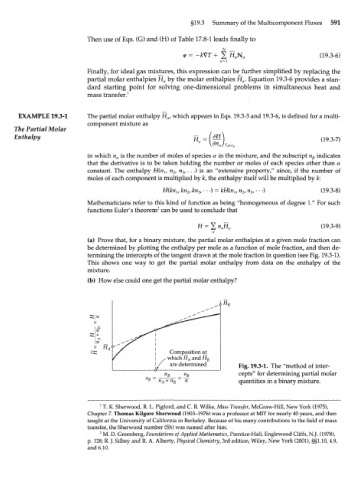Page 611 - Bird R.B. Transport phenomena
P. 611
§19.3 Summary of the Multicomponent Fluxes 591
Then use of Eqs. (G) and (H) of Table 17.8-1 leads finally to
= - + 2 H N a (19.3-6)
a
e
Finally, for ideal gas mixtures, this expression can be further simplified by replacing the
partial molar enthalpies H a by the molar enthalpies H . Equation 19.3-6 provides a stan-
a
dard starting point for solving one-dimensional problems in simultaneous heat and
mass transfer. 1
EXAMPLE 19.3-1 The partial molar enthalpy H , which appears in Eqs. 19.3-3 and 19.3-6, is defined for a multi-
a
component mixture as
The Partial Molar
Enthalpy = №) (19.3-7)
in which n a is the number of moles of species a in the mixture, and the subscript rip indicates
that the derivative is to be taken holding the number or moles of each species other than a
constant. The enthalpy H(n ]r n , n ,...) is an "extensive property/' since, if the number of
3
2
moles of each component is multiplied by k, the enthalpy itself will be multiplied by k:
Н(кщ, kn , kn 3 = кН(щ, n 2r n • (19.3-8)
2
3/
Mathematicians refer to this kind of function as being "homogeneous of degree 1." For such
functions Euler's theorem can be used to conclude that
2
H = 2 n H a (19.3-9)
a
(a) Prove that, for a binary mixture, the partial molar enthalpies at a given mole fraction can
be determined by plotting the enthalpy per mole as a function of mole fraction, and then de-
termining the intercepts of the tangent drawn at the mole fraction in question (see Fig. 19.3-1).
This shows one way to get the partial molar enthalpy from data on the enthalpy of the
mixture.
(b) How else could one get the partial molar enthalpy?
H A
Composition at
which H and H B
A
are determined Fig. 19.3-1. The "method of inter-
cepts" for determining partial molar
в = quantities in a binary mixture.
х n B
1
T. K. Sherwood, R. L. Pigford, and С R. Wilke, Mass Transfer, McGraw-Hill, New York (1975),
Chapter 7. Thomas Kilgore Sherwood (1903-1976) was a professor at MIT for nearly 40 years, and then
taught at the University of California in Berkeley. Because of his many contributions to the field of mass
transfer, the Sherwood number (Sh) was named after him.
2 M. D. Greenberg, Foundations of Applied Mathematics, Prentice-Hall, Englewood Cliffs, N.J. (1978),
p. 128; R. J. Silbey and R. A. Alberty, Physical Chemistry, 3rd edition, Wiley, New York (2001), §§1.10,4.9,
and 6.10.

